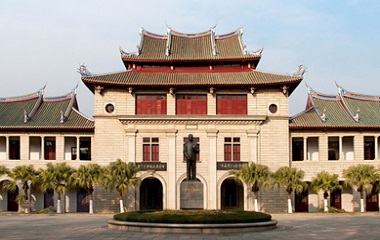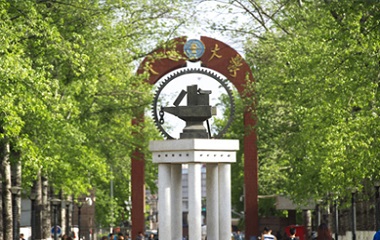[Uruguay] Li Dai Debora Shanlin, Beijing University of Technology
I am Uruguayan a postgraduate student admitted to study online by a Chinese college. Although I am 20,000 kilometers away, in a place the farthest in the world from China, it is always my hope to break the geographical barriers and get closer to China.

As part of my postgraduate research project, I was proposed to visit several local schools in Uruguay. One of these schools I was eager to go to was called the “Chinese Primary School.” I found out that it was funded by China, hence the name “Primary School of the People’s Republic of China.” Everyone calls it ‘China Primary School’. Not only did it have “China” in its name, but it also has an exchange program with a Chinese primary school. Every year, five Uruguayan pupils from this school can be sent to China to experience their life in a Chinese primary school and to interact with the pupils there. The more I read about the school, the more interested I became in it, and the more I wanted to see it myself. Unfortunately, I couldn’t wait any longer to get into the school because of the amount of paperwork and the slow process, so I had to try every means to get into the school as soon as possible. Finally, I had an idea. Maybe I could apply to teach a class and share what I have learned about Chinese culture!

I was fortunate enough a few weeks later to get on a trip with great enthusiasm to this “Chinese primary school,” and the journey revealed to me another feature of this primary school-its “unusual” location. I had heard that it was one of the most dangerous areas in Uruguay, with lots of robberies and crime of other kinds. Sometimes even the police were afraid to enter. Looking out from inside the car, I did not find the surroundings as scary as it was believed to be. There were just some dilapidated little bungalows and plainly dressed people when I was about to arrive at the school I found that there was still plenty of time for me to get everything settled. Suddenly, a big pit in the road blocked the way. I said to the driver, “It’s okay, just switch to another way”. However, the road taken was jammed because of the market, and the next road was still blocked because of a river running at the end of it. We drove from street to street, road to road, and the more we changed, the more isolated we became. There were some alleys that even drivers were afraid to get into. Going round and round in the same place we spent another ten minutes or so to get to the school.
We finally got to see the beautifully designed architecture of the primary school. The building was simple in shape, but what caught the eye was its colorful exterior – the vertical solar shading strips presented a gradation change of colors from sky blue to peachy pink, with the sunlight filtering through the gaps between them, giving the building the endless vitality. While I was wondering why a China-found primary school was built there, the driver said, “Such a beautiful school will surely make the children here enjoy their school life more.” It was then that I realized that a school could have such a significant impact on an area by changing the lives of the children and the future of that region.

I was standing outside the school appreciating the design of the building when suddenly the colored “shell” of the building started to move to the right and it turned out to be a sliding door. There I was greeted by the headmaster of the “Chinese Primary School”. We chatted as we walked through the colorful corridors towards the classrooms. What a different world inside from outside the school! The headmaster said that the construction of the primary school had made the area, which used to be like an abandoned area, so much more beautiful and the children were eager to come to school there. It was exactly what the driver had told me. I am happy for these children from the bottom of my heart.
The children greeted me cheerfully and politely as I entered the classroom. They could not wait to tell me that they would study hard so as to go to study in China someday in the future. “Why do you want to go to China?” I asked. “To visit the historical sites in China” some said. “To experience the high technology in China.” some others answered. Still some added that they wanted to learn the Chinese language and get to know the Chinese culture. I was deeply moved by the children’s eagerness for new things and new knowledge. While everyone was so excited, a child sat down and said, “Unfortunately, I can’t go to China this year because of the epidemic!” I quickly responded, “It’s okay! I’ll take you on a “cloud” trip to China today. Come with me!”
I then presented these lovely children the Chinese culture and the scenic beauty of different regions of China through a carefully prepared slideshow from the picturesque landscapes of Guilin and the waterside scenery of Jiangnan (regions south of Yangtze River) in the south of China, to the magnificent historical ancient cities and the Great Wall in the north, and then to several first-tier cities such as Beijing, Shanghai, Guangzhou and Shenzhen that represent the China’s new ear of wealth and power. The children stared intently at the pictures with curiosity. Their sights crossed one city after another, as if they were crossing the boundary between the poor and the rich and the distance between countries diminished.

Next, a long timeline was displayed on the whiteboard. I asked the children how many years China had been around. One of them replied “1,000 years”, stretching out his arms to show how long he thought it was. When I told them that China has had a history of 5,000 years, everyone in the classroom was amazed, “5,000 years! That’s a long history!” Before I could start with the Four Great Inventions of China, a few children had already given me the answer – compass, paper making, gunpowder and movable-type printing. I asked, “And what have these inventions contributed to the world?” A child raised his hand and answered instantly, “Making more people be able to read?” I said yes and went on with more questions “Do you know China’s new ‘Four Great Inventions’?” and this time no answer came. I told them that China’s new “Four Great Inventions” were high-speed rail, online shopping, QR-code payment and bicycle sharing. China has made great achievements in these new areas that are highly relevant to production and life today. The children expressed their admiration, “How wonderful! China is both historical and advanced, and we want to go there even more.”
I then moved on from the ancient China’s Silk Road, which stretched over thousands of miles and enabled the communication between many countries, to today’s Belt and Road Initiative, which has been adapted to the contemporary development and has promoted the exchange between countries and the mutual benefits. I explained that China has helped many countries to build their infrastructure through the Belt and Road Initiative.
Before I could ask, the children said, “So Uruguay is one of these countries, right?” I replied, “Of course. The construction of your school benefited from the Belt and Road Initiative.” The children were all very proud and kept holding their smiling little faces. I continued, “So, will you treasure the opportunity and keep studying hard in your school?” In unison the whole class shouted, “Y-e-s!”
“The China Primary School” is not simply a building, but a key to knowledge and hope. It gives those Uruguayan children knowledge, opens their eyes, broadens their horizons and their outlook. In a few years’ time, some of them may become the pioneers who will lead Uruguay to the world stage.
What a meaningful “cloud” tour!
The story is from "My Beautiful Encounter with China" Essay Competition organized by the Chinese Service Center for Scholarly Exchanges (CSCSE).










